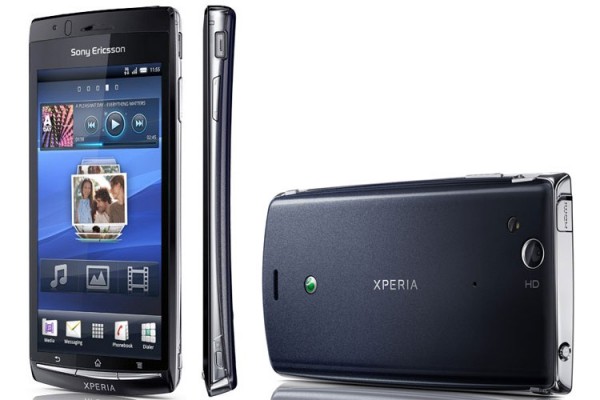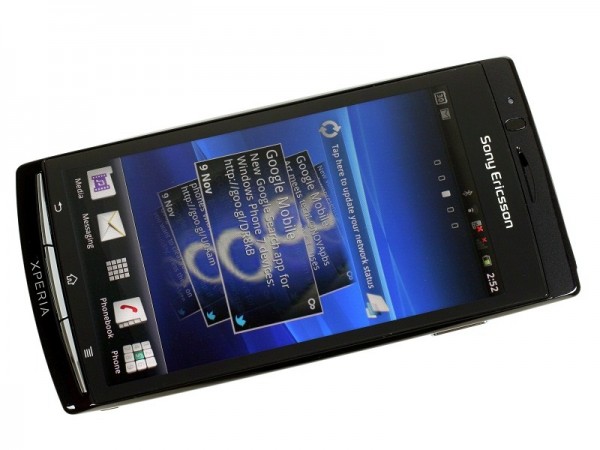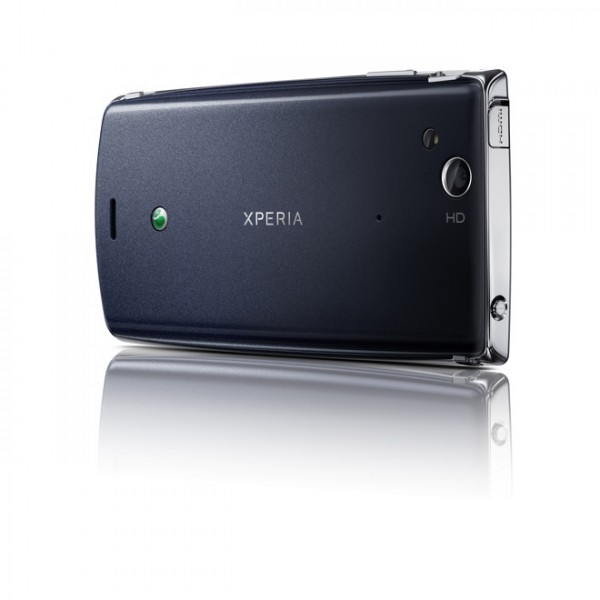
Hardware
Unfortunately, instead of a dual core processor, the Arc uses the Qualcomm’s Snapdragon, a single-core processor, which is a slightly more improved version than what is used on the original X10. The Arc generously offers 512MB of RAM and the Snapdragon processor is boosted with the Adreno 205 GPU, a minor improvement over the previous Adreno 200 found in X10. To recharge the device, a micro-USB socket is still used, however, it is no longer covered and it has been moved to right side of the handset. The absence of cover makes it easier to charge the device as you don’t need to open the cover. On the top left, you’ll find a 3.5mm headphone jack and a small LED is also present to show the charging status. Audio capability of the Arc is somewhat disappointing, when you ramp up the volume, its sound is far too inaudible, with signs of distortion and audio clippings. There’s no bass at all, this is a problem that plagues many thin smartphones, as the small speaker can’t produce a good enough sound.
Build, Screen and Camera

At first, you’ll see that the Sony Ericsson Xperia Arc is quite thin at just 8.7 mm and when compared with the earlier Xperia model, the X10, you won’t see much difference visually, except the for the Arc’s curved back. Consequently, the Arc seems to be a little thicker. However, once you hold it, the thinness is immediately apparent and it seems that Sony Ericsson has perfectly accommodated the “human curvature” on the Arc’s design.
Although it is somewhat sleek, the plastic cover raises some doubts about its durability and strength. The screen may look quite tough, however the chassis device and battery cover is made from plastic. But at least, it is designed solidly and doesn’t creak. The thinness brings its own consequences, for example the keys are quite tiny. When turning on the device, you need to firmly press the button and to control volume level, you need to use a rocking button.
The new phone uses the Android 2.3 (Gingerbread) and it is among a few phone models to utilize the Android version, although some Froyo (Android 2.2) phones, including the original X10 plan to get the upgrade to Gingerbread soon. The screen resolution is 480×854 pixels (capacitive), which is slightly higher than the resolution used on earlier Motorola’s devices (480×800). The LED backlight helps to make the phone thinner, brighter, easier to see outdoors and consume less power. The 1,500 mAh battery won’t be hard-pressed to satisfy users who to enjoy images and movies at brighter colors. Because there is no auto-brightness setting available, you may be quite tempted to ramp up its brightness level, which can help you to appreciate the wonderful screen technology at work. The software can analyze the images shown on the screen to manage saturation, enhance contrast and reduce noise on both still images and videos. The BRAVIA engine can be disabled, however the resulting images can feel a little unnatural, although you may get slightly longer battery life.

The Arc’s 8.1 Mp camera’s interface is significantly improved compared to the original interface found in X10 and it is able to capture 720p HD videos at 30 fps. By swiping your finger to the left, you can access the gallery and the right swipe brings you to important camera settings, all displayed comfortably in a single page. The options can be daunting to some, but tweakers will surely feel at home with these settings. Camera options include capture mode, camera resolution, touch capture, scenes, flash and timer. There is also a small capture button for the camera, which is quite a rarity nowadays. However, because it is so small, you need to hold the camera firmly while pressing the button and at the same time, you should make sure that the lens isn’t covered by your hands. Not too comfortable. It is better for you to use the touch capture feature instead, by tapping on an on-screen button to take the picture. The Arc uses a new sensor called Exmor R that has wider aperture to allow crisper images at low light environment or at higher shutter speed. In fact, it can do a much better job than the X10, which struggles in a dimmer place. But obviously, the image will still be really noisy in a place with very low light, consequently, to improve the picture quality, the LED light and the fill-in flash option should be enabled, as the result, the foreground objects will be cleaner and more well-defined, although the background will still be somewhat noisy. The resulting image quality is better than the X10, because the Arc doesn’t employ an overly aggressive file compression, with 2.5 MB file size on full resolution and maximum details as opposed to 1 MB on the X10.
Because, storage on latest smartphone is no longer at a premium, the Arc can cope with a lighter image compression technique. Other than the disappointing button, the Arc’s camera is extremely good. However, when you shoot videos, the frames will drop as the object movement ramps up, however at a capture rate of 6Mbps, the video quality is superb for a smartphone. Suffice to say, it is easy to fill up the entire 8MB card, if you shoot frequently, it means if you do plenty of filming, a separate memory card is in order.
Operating System, Interface and Apps

Sony Ericsson makes a minor modification on the Android OS, by adding a home screen app that seems to be influenced by the Apple’s iOS and Samsung’s TouchWiz UI. Users can scroll between five panels and with a pinching gesture, you can hide apps or show all widgets. Just like the iPhone, folder can be created automatically by dragging in app over another and the new folder can be renamed easily. Four commonly used apps and folders can be placed at the bottom of the screen and to see a list of all installed apps you can press the central icon. The list can be ordered by date of installation, usage frequency or alphabetically. When widgets and icons are moved, they behave in an iOS-like manner, which put plenty of attention to detail. Luckily, Sony Ericsson doesn’t add too many built-in widgets as if the designers understand that people most of the time do not use bloatware that only take up resources such as battery power and processor juice.
Sony Ericsson does add some widgets and fortunately they’re quite useful. The Arc has widgets for turning on/off flight mode, GPS and Bluetooth, launching media player, opening a media gallery and Timescape app. With the Timescape you can get updates on the Facebook, Twitter, Myspace and LinkedIn, it also allows you to see messages and recent calls. In general, the app is a good way to gather social network updates, calls and text massages in one app. Unfortunately, it doesn’t update quite well and it is a battery drain if you leave it enabled for a long time. As the result, if you use TweetDeck often, it is unlikely that you’ll turn to Timescape, as TweetDeck can support multiple accounts, notifications configuration and better searching. Another Sony Ericsson app is the LiveWare manager, which allows you to trigger a specific behavior during certain situations. This way, you can launch an app automatically, when you plug in the speaker or recharge the phone. An app called the Media Server can turn the phone into a Digital Living Network Alliance (DLNA) device, which is useful for creating a cloud network at home using Wi-Fi technology. For example, with a compatible TV you can play videos from your phone using the wireless network. The preinstalled BBC’s iPlayer app is also a good way to show off the Flash support on the Arc. It currently uses Flash Player 10.1, but can be quickly upgraded to 10.2, by simply downloading the latest player in Android Market.
Beside the above changes, the Arc is still largely a native Android phone and the interface is still significantly similar to phones that use stock Android Gingerbread, such as the Nexus S. Owners of the Arc won’t be burdened by many unnecessary apps and demos, which are often can’t be removed. The internal storage of the Arc is less than 320 MB and although the phone comes with an 8MB memory card, you’ll definitely need every byte you can get.
Verdict
Without any doubt, with the BRAVIA engine, the screen on the Arc is very appealing. However, due to the lack of automatic brightness control, you need to manually reduce the brightness to make the phone runs a little bit longer, as having a low battery warning at 2 PM at work, won’t be pleasant. Its concave rear fits well in our hand and despite the huge screen, it still feels comfortable in the hand. Using the apps and multimedia features is wonderful and once you play around with it a little, it’s hard to put the phone down. Despite the terrible speaker and the fiddly camera button, you won’t consider them a deal breaker, because you can still use the on-screen capture button and earphones. Of course, there is still room for improvement and hopefully, future updates will improve HD recording and tweak the camera, however as it stand today, potential buyers will be more than happy to get this lovely phone.










Comments